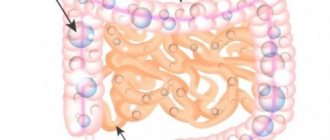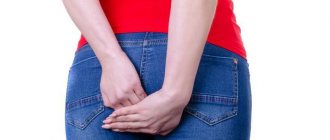Every person knows what color of stool is normal for him, and notices when the excrement takes on an unusual color.
The appearance of a light color in an adult is a symptom of insufficient production of digestive enzymes by the liver and pancreas.
The condition may develop due to a pathological process or be the result of taking certain foods or medications. Light-colored stool in an adult requires examination and search for the causes of clinical symptoms.
Why does stool become lighter?
A healthy person's stool should be brown. When blood cells break down, bilirubin is formed. It is located in the gallbladder, is part of the bile and penetrates the intestinal tract. Some of the bile is processed, resulting in a brown compound.
The reason for light-colored stool in an adult is the absence of this compound, which occurs in the following situations:
- when changing the diet;
- while undergoing a treatment course;
- after alcohol;
- during pregnancy;
- in the presence of certain diseases;
If the color of the excrement has changed, you should consult a doctor, as this indicates an illness. When diagnosing, the doctor notes the color of the stool, its consistency, and takes into account additional symptoms indicated by the patient.
What should the normal color of stool be?
A healthy body always has a strictly defined color of stool. It depends on many factors of digestion and food processing, so it can be used to determine the state of body functions.
Bilirubin is mainly responsible for the color of stool. This substance is contained in bile, through which it is excreted from the body along with digestive waste. Bilirubin is formed from hemoglobin, which occurs during the breakdown of red blood cells and their replacement by new cells. A healthy body regulates this function, so the rate of bilirubin excretion in it is identical, regardless of age, gender and race.
The normal color of stool, provided by bile, is brown. But its shade may vary depending on the type of diet that nourishes the body.
The following shades of feces are allowed (Table 1).
| Stool color | Characteristic |
| Dark brown | This is the standard color of feces in a healthy person on a mixed diet. |
| Light brown | This shade occurs with a strict plant-based diet that does not harm the body. |
| Black-brown | Having a lot of meat in your diet makes your stool darker |
| Light yellow with orange tint | Occurs with a strict dairy diet |
If you experience stool of a different color, you should consult a doctor. This is influenced not only by the proportion of bilirubin, but also by other factors such as internal bleeding, digestive disorders, stagnation in the intestines and the like.
The normal color of stool, regulated by the bilirubin content of bile, is brown. It has different shades, depending on the patient's diet.
The drugs may change the color of feces. An unreasonable change in color or shade indicates disturbances in the vital processes of the body.
Find out what the color of the chair should be from the following video:
Foods that cause stool lightening
You can figure out what exactly caused the discoloration of stool - illness or dietary habits - by monitoring the frequency of acholic stools. If the case is isolated, then it is quite possible that a person’s diet contains many fatty foods. An excess of fat in food leads to decreased bile production. Following this, the color range of feces is reduced to pale yellow, beige and gray shades.
Foods that cause stool discoloration include:
- a number of dairy products: sour cream, cottage cheese, fermented baked milk, yogurt, kefir,
- fats of various kinds - vegetable oil, butter, mayonnaise, lard,
- banana, melon,
- alcohol,
- rice, oatmeal porridge,
- vegetable and fruit purees.
What to do in such a situation? It's very simple: you need to stop eating, or reduce the amount of the above foods in your diet. This will allow the stool to return to its normal color very quickly.
The main distinguishing feature of acholic stool caused by diet is the absence of any complaints about well-being and health. All people who encounter this problem, for example, due to an excess of milk in the diet or various fats, do not experience dangerous symptoms.
Therefore, if there is no diarrhea, fever, chills, abdominal pain, skin rashes and other warning signs with colorless stool, there is no need to sound the alarm.
What determines the color of stool in an adult?
With a rational human diet, the color of the stool is determined by the normal functioning of the gallbladder and the production of bilirubin. This substance is secreted simultaneously with bile and food waste, which gives the feces a dark color. Why yellow stool appears in a patient is determined by various reasons and factors affecting the body.
The normal color of feces is dark brown, but some dietary habits can significantly change it:
- Black or too dark stool indicates that a person eats too many meat dishes.
- A pale brown color of stool is observed in people with a high content of plant products in their menu. This diet fully meets the needs of the body and does not cause any deviations in the functioning of the intestines. It is normal to have a small amount of mucus in brown stool.
- Light yellow or orange stool is observed in those patients whose diet contains exclusively dairy products. Stools of this color are often observed in newborns who are fed breast milk. Such babies have white inclusions in the form of grains in their feces, which are lumps of poorly digested milk from a woman.
Liquid green-yellow stools with the formation of foam, in which inclusions of blood or a large amount of mucus are noticeable, require the patient to consult a specialist. Green feces in combination with other symptoms may indicate poisoning, bleeding, problems with the functioning of the stomach and infectious lesions of the intestine in the acute stage.
Light stool: list of possible diseases
For some serious diseases of the liver and gallbladder, the lightening of excrement is an important sign for their diagnosis. Light-colored stool is a symptom of many diseases, but the most likely causes are problems with the gallbladder, biliary tract and liver. Tumors and inflammations in different parts of the digestive tract are less likely.
Let's consider common diseases that can cause the appearance of light-colored stool:
- Crohn's disease is an extensive lesion of the intestinal tract, when the functioning of all parts of the intestine is disrupted, which manifests itself as a severe disorder.
- Biliary dyskinesia. With this disease, the secretion of bile from the gallbladder becomes difficult due to a decrease in its contractility. Accordingly, bile enters the duodenum in smaller quantities, and the color of the stool becomes lighter.
- Hepatitis of various etiologies - inflammation of the liver does not go away without a trace and the first sign that helps to suspect pathology is light intestinal contents, plus dark urine is added and feces over time do not just lighten or turn white, but become completely discolored.
- Pancreatitis - disturbances in the functioning of the pancreas affect the contents of the intestines, since the first enzymes that enter the intestinal tract are secreted by the pancreas. If they are deficient, serious digestive problems occur and the stool becomes very pale.
- Cholecystitis - the stool becomes mushy and light-colored, and diarrhea is noted. There are other symptoms, but they appear a little later after the discharge of beige or white feces.
- Bend of the gallbladder. This problem is accompanied by decreased motility of the gallbladder and ducts. As a result, the organ, important for good digestion, works less productively, bile acids are supplied to a minimum, causing a light color like an adult.
- Fermentative dyspepsia - stool has a foul, sourish odor, often the stool is quite liquid and light, sometimes even completely uncolored.
- Oncological diseases of the intestines, liver, pancreas or gall bladder - the disease has reached the phase of active development, since the first period is asymptomatic. Whitish or light yellow stool will be accompanied by abdominal pain, since the tumor has already grown in size and can now block the ducts for secreting enzymes or even part of the intestine.
- Infection with helminths. In this case, white particles and larvae can be observed in the feces. Their number depends on the degree of intestinal infection.
These diseases are dangerous for strong adults, and for an elderly person they can even become fatal. Therefore, if the stool changes to light-colored and other symptoms of pathology begin to appear, you should immediately seek help from a specialist. If you carry out diagnosis and treatment on your own, you can worsen your situation, so it is better not to do anything at random, but to find out how to treat the disease from an experienced doctor.
Prevention
In order to never encounter the indicated symptoms associated with lightening of the stool, care should be taken to eliminate the causative factors that contribute to the appearance of light yellow stool in people of the adult age group. To do this, it is recommended to perform the following preventive measures daily:
- follow the rules of personal hygiene and always wash your hands thoroughly before eating;
- minimize contact with domestic and farm animals, which are essentially carriers of parasite larvae, viral and bacterial infections;
- eat only high-quality, fresh and biologically healthy food;
- stop drinking alcohol and carbonated drinks, as well as tobacco products;
- monitor the health of the liver, pancreas, gall bladder, promptly identifying their pathologies and inflammatory processes in tissues;
- take antibacterial drugs only in extreme cases and as prescribed by your doctor;
- provide the body with moderate physical activity in the form of walking in the fresh air, cycling, swimming, jogging;
- avoid psycho-emotional stress, sleep at least 8 hours a day, and also limit yourself to a sedentary lifestyle, which negatively affects the functional abilities of the liver.
These simple rules are the key to stability in the functioning of the human gastrointestinal tract and at the same time prevent the occurrence of the causes of such an unpleasant and painful symptom as light yellow feces, released in liquid or normal form.
After taking medications
There are a number of medications that can cause lightening of excrement. These include:
- antibiotics;
- anti-inflammatory drugs;
- antipyretics (aspirin, ibuprofen, paracetamol);
- antifungal agents;
- drugs for the treatment of tuberculosis;
- gout medications;
- drugs for the treatment of epilepsy.
If you have undergone an examination such as an x-ray of the gastrointestinal tract or other procedures in which it is necessary to take barium sulfate, then 2-3 days after the stool will very sharply lighten. When the barium is completely removed from the body, the excrement will return to its normal color.
What does it mean
Bile and bilirubin color stool brown or any other color, such as yellow. The shade and color of stool depends on the percentage of these two substances. Bilirubin is formed after the breakdown of red blood cells, which is why the color of the stool is so rich. If the color of the stool changes to yellow or something else, it means the amount of bile and bilirubin has changed.
The color may change due to a malfunction in the body, then the body will repair itself within a few days. If a change in stool color is accompanied by abdominal pain, vomiting and other painful conditions, consult a doctor for diagnosis and treatment.
After alcohol
What can be light in stool after alcohol abuse? Everything is connected with the fact that when drinking alcohol, the liver needs to cope with its functions - remove toxins from the body. If a person also abuses fatty foods, such a load on the organ is unbearable. A person may also notice the appearance of light-colored diarrhea.
In our body, the liver acts as a filter. Its main task is to pass all harmful substances through itself. If a person regularly drinks alcohol, the cells begin to break down. It takes time for the structure to recover. If it is not there, the process slows down each time, and hepatitis begins to develop. One of the symptoms of this serious disease is light-colored stool. Hepatitis can also be accompanied by darkening of the urine, yellowing of the sclera of the eyes, stabbing pain in the abdomen, etc.
What diseases does yellow stool indicate?
What the appearance of yellow stool indicates can only be determined by a specialist after a thorough diagnosis. Mostly, such stool is a sign of deterioration in the functioning of the digestive system. With such pathologies, not only a change in the color of feces is observed, but also the development of certain symptoms.
Pancreatic dysfunction
The pancreas is an organ that performs two important functions in the human body. Firstly, it produces juice, without which the normal process of digesting foods entering the intestines is simply impossible. The second function of the organ is the production of hormones and regulation of metabolism in the human body. With minor disturbances in the functioning of the organ, the development of certain symptoms is noted.
Pale yellow stool with foam most often appears with the following diseases of the pancreas:
- pancreatitis;
- oncological diseases;
- pancreatic necrosis;
- cystic formations;
- cystic fibrosis.
Yellow feces with foam are a sign that the process of breaking down foods that have entered the intestines has been disrupted.
If you suspect any of these pathologies, before starting drug therapy, you should avoid eating too spicy, salty, fatty and smoked foods. The diet of patients with such diagnoses should be dominated by natural foods in the form of cereals, soups and boiled meat.
Unstable liver function
Feces can become yellow-white in color due to the formation of stones in the gallbladder and its ducts, cholecystitis. In addition, such a symptom can be observed when the pancreas presses on the bile duct and during rehabilitation after removal of the affected organ.
In such pathological conditions, the urine becomes dark and severe pain appears. It is especially noticeable after drinking alcoholic beverages and eating foods containing fat. The main location of severe pain most often becomes the area on the left under the ribs.
Symptoms
In the case when light-colored stool is accompanied by additional clinical signs, it is necessary to visit your doctor.
You need to pay attention to symptoms such as:
- attacks of nausea and vomiting;
- darkening of urine;
- pain in the abdominal area;
- decreased appetite;
- flatulence;
- mucous impurities in feces;
- yellowing of the skin and eye sclera;
- rapid loss of body weight;
- heat.
If there are at least two additional signs with light-colored stool, it is necessary to undergo a medical examination to determine the diagnosis. With some problems, for example, with advanced pancreatitis, the count is not days, but hours. Be attentive to symptoms and do not ignore serious ailments.
If the stool is red in color
Some foods can give stool a red tint: red beets, tomatoes, tomato sauce in large quantities, fruit juices.
The presence of a red tint in the stool may indicate bleeding in the lower intestines, in which case the blood does not darken to black. If, in addition to this symptom, diarrhea, abdominal pain, fever, loss of appetite appear, you must urgently seek medical help.
The presence of blood in human feces may indicate anal fissures, hemorrhoids, and bleeding in the rectum.
Changes in the color of stool can be caused by a variety of reasons. If light-colored stool appears, analyze your diet the day before. If your condition worsens, your temperature rises, and other symptoms of gastrointestinal distress occur, do not hesitate to seek medical help.
Hormonal disorder
The yellow color of stool while maintaining its normal consistency may be due to hormonal imbalances in the body, which can occur in both women and men. This is explained by the fact that with a lack or excessive amount of certain hormones, the peristalsis of the small and large intestines increases, therefore, food does not have time to break down normally.
What does yellow stool mean in an adult, what causes the color change, what symptoms and signs are accompanied, what to do and how to treat yellow stool, what complications are possible.
Shade of stool and possible causes
The concept of “light feces” is very vague, because there are several options for light. The color of stool in an adult can indicate possible diseases, pathologies or other causes.
Depending on the color of stool, the following reasons are distinguished:
- Light green. Consumption of food dyes, sweet water, sweets, alcohol, herbal medicines. Among the diseases are dysbacteriosis, gastrointestinal infections (feces with impurities of blood, mucus and pus), acute enterocolitis.
- Light brown. Eating predominantly plant foods, accelerates the passage of food particles through the colon.
- Light yellow and beige. Bilirubin is secreted along with bile, which gives this color. Yellow stool in a healthy person is normal, but if it is beige, then this means a narrowing of the bile ducts and unstable production of bilirubin.
- White feces and dark urine. Acute phase of hepatitis, dysfunction of bile formation. Urine becomes dark in color due to the fact that during hepatitis, bilirubin is excreted through the kidneys and skin (therefore the skin turns yellow).
- White and foamy feces with dots, strings, mucus. Helminthic infestation, which leads to the development of hepatitis, dysbacteriosis, and digestive disorders.
- White feces and foul odor, diarrhea. Intestinal infection, chronic digestive disorder, pancreatic insufficiency.
The color of stool and its consistency are important diagnostic signs, so you should not remain silent at a doctor’s appointment, considering this an uncomfortable topic of conversation. It is better to immediately report all disturbing symptoms in order to quickly receive the necessary help in treatment.
When exactly should you see a doctor?
Yellow feces do not always immediately bother an adult, but this is until other symptoms of the pathology appear. And then it becomes impossible not to react to a strange sign.
You should definitely visit a doctor if:
- Abdominal pain of any nature appeared.
- The abdomen is abnormally soft or hard.
- Yellow feces are pinkish in some places, that is, they contain blood.
- There is a light state of feces and at the same time dark urine.
- The feces are loose, sandy, and eventually cease to be formed at all.
- Nausea appears, sometimes even to the point of vomiting.
- Vomiting appeared like a fountain, especially richly yellow in color.
- Diarrhea or constipation alternate.
- The temperature began to rise, slightly, but did not fall for a long time.
- Weakness occurs.
- No desire to eat food.
Seeing a doctor with such symptoms is simply a mandatory step, otherwise you can bring the disease to its peak and your health condition to critical. An experienced specialist will help you understand the reasons for the appearance of yellow stool in an adult and tell you what to do in each specific case.
Diagnostics
To identify disorders in the digestive system and organs of the gastrointestinal tract, the following types of analysis are prescribed, which are also associated with a complete study of feces:
- Blood chemistry. Search for discrepancies in the number of leukocytes and hemoglobin with the norm;
- Coagulogram. Study of blood clotting rate;
- Coprogram. Examination for hidden blood, mucus and pus in bowel movements;
- Test for worms. Methods used: enzyme immunoassay, CPR;
- Colonoscopy. Examination of the colon with the subsequent possibility of further biopsy and collection of cellular material;
- CT, MRI, ultrasound examination. Visual examination of internal organ lesions that cause changes in the color of stool.
All the results obtained will help the doctor make the correct diagnosis and find the causes of light-colored stool in a person.
What to do, which doctor to go to and what tests to take?
After discovering feces of a bright shade or a rich light color, every adult should waste no time making an appointment with a gastroenterologist to undergo a comprehensive examination of the body and the organs of the digestive system itself. If a specialist of this profile is not present in the clinic, then his duties are performed by a general practitioner. The doctor will see the patient, palpate the surface of the abdomen, and try to detect possible foci of the inflammatory process inside the abdominal cavity.
After this, based on the patient’s complaints, the doctor prescribes the following mandatory types of tests and diagnostic measures, the results of which are essential in selecting a therapeutic course:
- venous blood for its biochemical examination for viral microorganisms that can cause hepatitis, the presence of cancer cells, the level of bilirubin and the percentage of key components of this human biological fluid are determined;
- stool samples to determine whether a person has a disease such as helminthiasis or intestinal dysbiosis;
- Ultrasound diagnostics of the abdominal organs, which displays in detail the condition of the tissues of each internal organ separately, provides comprehensive information about its diffuse changes and whether they can cause the appearance of light yellow stool;
- endoscopic examination of the small and large intestines, as well as other segments of the digestive tract (a special endoscope probe is inserted into the patient’s anus, which transmits to a computer monitor a high-quality digital video image about the condition of the gastrointestinal mucosa from the inside, as well as the presence of other possible pathologies);
- clinical finger blood test (in a laboratory, doctors determine the level of glucose, as well as the number of vital cells responsible for most processes in the body of an adult).
At the same time, a separate blood test for hormones is performed. It is very important that their ratio is balanced, since a decrease in the secretory activity of the glands of the endocrine system or their sharp increase can also cause a change in the color of the stool.
In particularly complex clinical cases, the patient is prescribed an MRI in order to learn in more detail about the causes of the disorder in the functioning of the organs of the digestive system and, accordingly, to formulate an effective treatment regimen.
What to do if the stool is light?
If you notice light-colored stool, first of all you need to:
- Establish a diet, eat at strictly defined hours, little by little, but often.
- Eliminate fried and fatty foods from your diet, and you also need to reduce the amount of dairy products you consume.
- In addition, you should completely abstain from alcohol.
If the desired effect is achieved, you need to reconsider your lifestyle, think about the fact that with disordered eating and alcohol abuse, all systems and organs suffer - liver, kidneys, pancreas, heart, etc.
If it has been noticed that a light-colored stool has appeared in an adult, and everything is accompanied by nausea, vomiting, high fever, weight loss, diarrhea, you need to consult a doctor as soon as possible. Only an experienced specialist will be able to determine the cause of this phenomenon and help get rid of disturbing symptoms.
What does dark stool mean in adults: causes and treatment Low blood pressure: causes, symptoms, treatment and consequences Epilepsy: symptoms, causes and treatment Worms in humans: symptoms and treatment at home
What to do?
Having noticed a change in the color of feces, an adult should not ignore this fact.
Definitely worth it:
- Analyze the possible causes of changes in the color of feces.
- Look and think about whether there were other oddities in the body’s functioning (nausea, reluctance to eat, vomiting, fever, etc.).
- Change your diet if this may be the likely cause of the change in stool color.
- If possible, stop taking medications. And if not, consult with the current specialist who prescribed them about the appearance of yellow stool, it could just be a side effect.
- If no visible causes are found, it is worth getting diagnosed at the hospital.
- Submit feces for coprogram and bacterial culture.
- Do an ultrasound of the liver, gallbladder, and pancreas.
- Donate clinical blood and biochemical blood.
Video:
After diagnosis, if the results leave much to be desired, you should contact a specialized specialist - a gastroenterologist. Next, he will prescribe treatment based on the established diagnosis.
Starting treatment on your own is contraindicated. The only thing an adult can do is balance the diet, give up bad habits and take unnecessary, non-vital medications (laxatives, sorbents, etc.).
Yellow water diarrhea
The act of defecation should occur every day, once or twice. Any deviations require special attention, often even treatment. Bile secreted by the gallbladder is involved in the formation of excrement. It is this that gives the brown color to feces, more precisely the pigment bilirubin, which is one of the components of bile. When bile is not produced in sufficient quantities, the stool is not completely saturated with pigment, and as a result we have yellow excrement.
Stools of a characteristic color with water indicate both a severe infectious disease and a banal indigestion. If there is no fever, unbearable pain in the epigastrium, nausea and vomiting, we can talk about indigestion. During this period, you should switch to dietary nutrition, eat pureed food little by little but often, and drink antidiarrheal medications. If relief does not occur after 2 days, you should consult a specialist.
When bile is not produced in sufficient quantities, the stool is not completely saturated with pigment, and as a result we have yellow excrement.
Watery diarrhea is caused by bacteria that are most common in the summer. Sometimes such a long-lasting symptom can be caused by infection with parasites, such as Giardia. Very liquid stool is directly related to damage to the small intestine. The risk of this diarrhea is due to the fact that severe dehydration occurs. Infants are most prone to developing this condition.
Severe infectious diseases are accompanied by diarrhea with the release of yellow feces with water, high body temperature, pain, cramps, a sharp deterioration in the general condition of the body, and vomiting. In this case, do not self-medicate. This means that urgent qualified help is needed.
Prevention of diarrhea
In order for the body to fully recover, it is necessary to maintain proper nutrition. To maintain water balance, you should drink intensively for 14 days. To prevent diarrhea, it is recommended to maintain good personal hygiene. If a person has previously suffered from diarrhea, then probiotics are taken as a preventive measure. It is recommended to drink a decoction of St. John's wort or herbal tea.
Depending on the signs and changes in stool color, a person should pay close attention to their health. Stool mixed with secretions that were previously unnoticed can become a symptom of a serious illness. In most cases, the problem is considered to be yellow diarrhea with possible variations. A person needs to pay attention to additional symptoms. Sometimes this refers to the manifestation of adaptation of the body.
We recommend: How to properly dilute potassium permanganate for diarrhea?
Treatment
Treatment of yellow stool begins with diet. If the diet does not help, you need to add medications.
Eliminate coloring foods (carrots, milk, etc.) from your diet. If after 1-2 days the stool begins to return a brown tint, everything is fine.
If you are sick and take medications, consult your doctor about possible side effects.
If a change in stool color is accompanied by abdominal pain, diarrhea, loss of appetite, weight loss, fever and other negative conditions, consult a doctor for a diagnosis and treatment.











